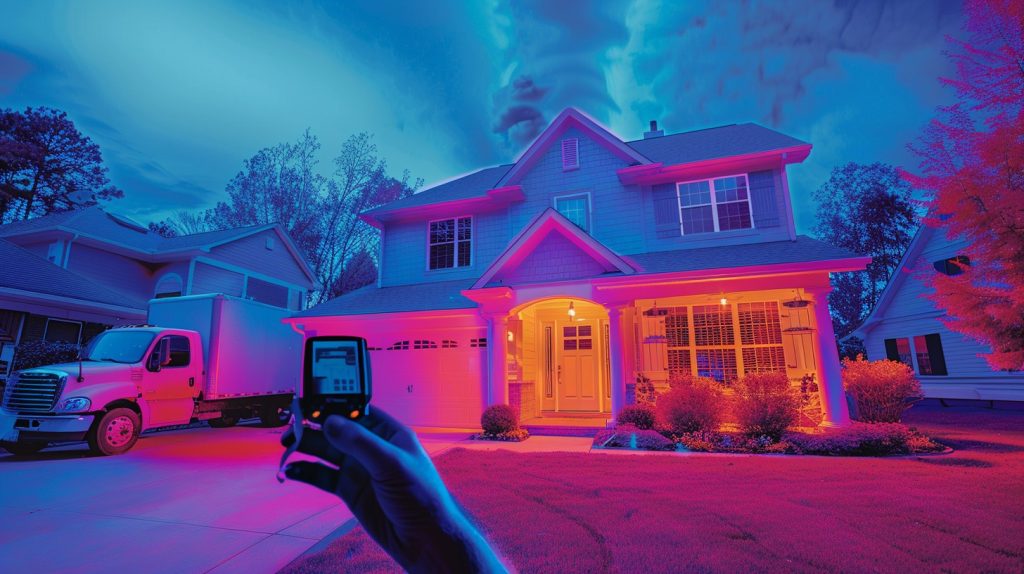3 Tools That Uncover Hidden Home Hazards: How BPG Uses Moisture Meters, Thermal Imaging, and Borescopes in Ohio Inspections
When relying on visual-only inspections, you may miss critical hidden issues in your home, such as moisture damage, electrical faults, and insulation gaps. To uncover these hazards, tools like moisture meters, thermal imaging, and borescopes are essential. Moisture meters accurately detect hidden water damage and prevent mold growth. Thermal imaging identifies heat loss, overheated electrical panels, and roof leaks that aren’t visible otherwise. Borescopes visualize hard-to-reach areas like crawlspaces and wall cavities, detecting pest infestations and structural damage. By using these tools, you can get a more thorough inspection, especially in older Ohio homes where hidden issues are common. Continuing to explore these methods will provide you with a clearer picture of your home’s condition.

3 Tools That Uncover Hidden Home Hazards: How BPG Uses Moisture Meters, Thermal Imaging, and Borescopes in Ohio Inspections
When inspecting older homes in Ohio, you face unique challenges that visual-only inspections can’t address. To uncover hidden hazards, BPG inspectors use specialized tools like moisture meters to detect water behind surfaces, thermal imaging cameras to reveal heat signatures indicating drafts or electrical issues, and borescopes to access tight, hidden areas. These tools are essential in identifying concealed leaks, pest activity, and insulation gaps, especially in homes exposed to Ohio’s harsh freeze-thaw weather.
The Problem with Visual-Only Inspections in Older Ohio Homes
When inspecting older Ohio homes, relying solely on visual inspections can miss critical issues, as many problems such as hidden moisture, electrical faults, and insulation gaps are not visible to the naked eye. These concealed hazards can lead to structural damage, mold growth, and costly repairs if left undetected. Using specialized tools like moisture meters and thermal imaging cameras helps uncover these hidden threats, ensuring a more thorough and accurate inspection.
Why Many Issues Stay Hidden Without the Right Tools
In older Ohio homes, particularly those built before the 1980s, many potential issues remain hidden from the naked eye, highlighting the limitations of visual-only inspections. Without tools like moisture meters, thermal imaging cameras, and borescopes, problems such as hidden mold, electrical issues, and insulation gaps can go undetected. Moisture meters reveal water behind surfaces, thermal scans expose heat signatures from drafts or overloaded circuits, and borescope crawlspace inspections uncover issues in tight spaces, especially significant in homes vulnerable to Ohio’s freeze-thaw weather. These tools are essential for identifying concealed leaks and pest activity that visual inspections might miss.
Moisture Meters: Finding Leaks Before They Become Mold
When using moisture meters to inspect your home, you’re relying on tools that can accurately detect hidden water damage. Pin-type moisture meters use probes to measure the moisture content of materials, while pinless meters use electromagnetic sensors to scan surfaces without causing damage. Both types help you identify wet areas, such as behind walls or under flooring, before they lead to mold growth or other serious issues.
How Pin-Type and Pinless Devices Detect Hidden Water Damage
Moisture meters are essential tools for detecting hidden water damage in homes, and they come in two primary types: pin-type and pinless. At BPG Inspections in Ohio, a pin-type moisture meter inserts pins into the material to measure moisture content accurately, ideal for confirming a plumbing leak under the floor. In contrast, pinless moisture detection uses electromagnetic signals to quickly locate moisture without damaging the surface, making it perfect for home inspections.
Thermal Imaging: Seeing the Invisible Threats
When using thermal imaging cameras, you can quickly identify areas where your home is losing heat, such as drafty attics or poorly insulated walls. These cameras also help detect electrical issues by revealing overheated panels or circuits, which can be a fire hazard if left unchecked. Additionally, thermal imaging can expose roof leaks and other moisture intrusions that might not be visible to the naked eye, especially in homes subjected to Ohio’s fluctuating weather conditions[1][2][4].
From Drafty Attics to Overheated Panels and Roof Leaks
Thermal imaging cameras are an essential tool in uncovering hidden home hazards, particularly in older homes in Dayton and Cincinnati that are prone to issues like drafty attics, overheated electrical panels, and roof leaks.
- Drafty Attics: Detect heat loss and insulation gaps using a FLIR thermal camera.
- Overheated Panels: Identify electrical panel overheating, a potential fire hazard.
- Roof Leaks: Locate hidden water damage and roof leaks before they escalate.
- Foundation Cracks: Discover foundation cracks behind drywall using thermal imaging.
- Hidden Moisture: Complement findings with moisture meters to confirm water issues.
Borescopes: Exploring Where Eyes and Hands Can’t Reach
When inspecting older homes in Dayton and Cincinnati, borescopes allow you to gain real-time views of hard-to-reach areas like crawlspaces, wall cavities, and HVAC systems. These tools help you identify hidden issues such as pest infestations, structural damage, and insulation gaps without the need for invasive procedures. By using a borescope, you can visualize the interior of walls, behind appliances, and within tight crawlspaces, providing a clearer picture of the property’s condition.
Real-Time Views of Crawlspaces, Wall Cavities, and HVAC Systems
Borescopes are indispensable tools for home inspectors, particularly in areas like crawlspaces, wall cavities, and HVAC systems, where direct visual access is impossible. Here’s how they enhance your inspection:
- Inspect tight spaces: Borescopes allow you to visualize inside walls, under floors, and within HVAC ducts.
- Detect hidden moisture: Combine borescopes with moisture meters to identify water damage in wall cavities.
- Analyze HVAC performance: Use borescopes for HVAC duct inspection to check for blockages or leaks.
- Identify pest activity: Borescopes help spot signs of pests in hidden areas, especially in pre-1980s homes in Ohio.
- Complement thermal imaging: Borescopes and thermal imaging cameras work together to reveal heat anomalies and structural issues.
